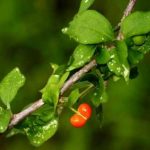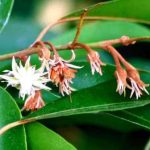TREE LIFE
July 2004
MASHONALAND CALENDAR
Saturday 3rd July. Botanic Garden Walk. Meet in the car park at 10.45 am for 11.00
Sunday 18th July A return visit to Mr. Kevin Fallon’s Pleasant Valley property. This time we hope to explore the riverine section.
Bring a chair and a plate and cutlery as Kevin is treating us to potjiekos (sadza and nyama in a 3-legged pot), we will meet at the farmhouse at 9.30 am.
Saturday 24th July. Mark’s walk will be at the Ruwa Scout Park. This is on the left, about 21 kms from Harare on the Mutare Road. As usual the meeting time is 2.30 pm.
Saturday 7th August. Tom will be away but Meg Coates Palgrave or Mark will lead the walk.
MATABELELAND CALENDAR
Nothing has been arranged for July.
As Anne Mullin has emigrated to UK, Lyn’s book Historic Trees of Zimbabwe will be available from Maureen Silva-Jones – while stocks last of course.
BOTANIC GARDEN WALK: 1 MAY 2004
The subject today was billed as the genus Strychnos, a woody genus we have had difficulties with in the past. In practice, a number of other interesting species which were not strychnos were seen and these will be included in this write-up. This was also Tom’s last walk for a few months as he intends to be away in Europe over the summer.
The genus Strychnos belongs variously to the family Loganiaceae or nowadays to the Strychnaceae. It has the following features:
plants are woody (trees, shrubs or climbers)
leaves are opposite
leaves 3-veined often from just above the base
spiny (in a few cases)
may have tendrils (if climbers)
stipules a vestigial rim
flowers usually white, yellowish or green
fruit a usually spherical berry
The first species looked at was Strychnos mitis. This is a species of medium altitude rain forest and in the Chirinda Forest it becomes an enormous canopy tree achieving 50 metres in height. The one in the Botanic Garden had achieved no more than 5 m in height after 25 years – does this imply that the giants at Chirinda are thousands of years old?
One unusual feature of the tree which was pointed out by Tom was the exceptionally thin bark, which is most unusual for such a large species. It not only occurs at Chirinda but also in various other outliers: for example in a forest south of the Zimbabwe Ruins and on Wedza Mountain.
After the rather rare S. mitis, we looked at Strychnos spinosa, a very common species in miombo woodland and one which we often encounter on Tree Society walks. This is a spiny tree with exceptionally large fruits, each with a hard outside and soft fleshy inside. It resembles closely S. cocculoides, but that species is usually readily separated by the thick corky bark. A further interesting difference, mentioned in FZ, is that the ovary is 1-celled in S. spinosa and 2-celled in S. cocculoides. Tom mentioned that he had tried to grow cocculoides in the gardens but all 20 plants had died – it is one of these sandveld species which will not grow in the area of the Gardens.
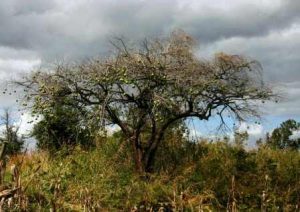
Strychnos spinosa. Photo: Bart Wursten. Source: Flora of Zimbabwe
An interesting thing about S. spinosa is that there is a “lowveld form”. We saw this right at the end of the walk. Superficially, it looks somewhat different to the typical form of medium and high altitudes. This particular specimen had been collected on Lone Star Ranch. Is this a further species awaiting taxonomic recognition or just a variant of spinosa? It would be interested to hear a specialist’s comment on this issue.
Another species, this time requiring Kalahari sand, which also cannot be grown in the Gardens is Strychnos pungens. “Pungens” in this context does not mean “with a strong smell”, but “ending in a sharp rigid point”. It refers to the leaves which have an extraordinary spine-like apex.
On next to Strychnos decussata, a species with small leaves which occurs in the southern lowveld, for example in the Mahenyas and at Ngundu Halt.
That completes the strychnos part of the walk. Another species of interest seen was the Pepper bark, Warburgia salutaris.
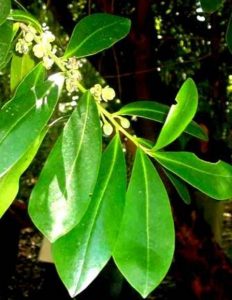
Warburgia salutaris. Photo: Mark Hyde. Source: Flora of Zimbabwe
Well-known as one of Zimbabwe’s rarest trees, one which is under threat from nangas. This particular tree in the Gardens had itself had several sections of bark removed. Tom mentioned that it was useful as a cure for muscular pain and chewing it can relieve toothache.
Ecologically it occurs on the ecotone between woodland and rain forest at low altitudes; Tom explained that this is a rare habitat in Zimbabwe and on that basis alone it is likely to be a rare tree in this country.
The leaves are alternate and shiny and are asymmetric – the mid vein divides the leaf into unequal parts.
Tom mentioned that attempts were being made to grow the species commercially in South Africa and Zimbabwe.
A very beautiful species seen on the walk was Turraea obtusifolia. This is a shrub with small dark green leaves but made most striking by the large white flowers.
Afrocrania volkensii belongs to the family Cornaceae. It is a tree which looks a bit like a Cornus (which is a N Hemisphere family) with prominent leaf venation. It grows in some of the wettest places in Zimbabwe, namely at 2100 metres on boulder screes at Nyangani. It goes down to lower altitudes along side the streams.
We also saw Curtisia dentata in the Eastern Districts section. This is another Cornaceae; again, in Zimbabwe it is confined to the Eastern Division, where it occurs in high altitude forests. It has opposite, dentate leaves and these are unusual for a forest species in being brown-hairy.
All in all, another interesting evening’s walk. Once again, we thank Tom for giving up his time for the Society.
-Mark Hyde
THETFORD ESTATE: AGM: 9 MAY 2004
After much to-ing and fro-ing and general indecision, we finally moved the date of our AGM to one week earlier in order to avoid the clash with the Eastern Districts Symposium date. By kind permission of Mark Brightman, the wildlife manager, we were privileged to hold our AGM at Thetford Estates in very pleasant surroundings on the lawn adjacent to the offices.
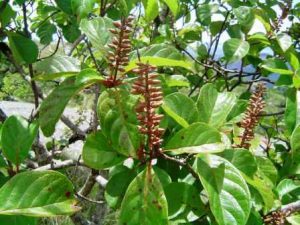
Hymenodictyon floribundum. Photo: Bart Wursten. Source: Flora of Zimbabwe
One problem with AGMs is that they eat into botanizing time. However, after the meeting, Mark (Brightman) drove us up into some rocky hills on a neighboring farm, called St Gerera. Here we scrambled upwards a little way, noting the typical flora of rocky hills such as Hymenodictyon floribundum (the Fire bush) and Brachystegia glaucescens (Mountain acacia). A short steep scramble downwards then brought us out at some fabulous cave paintings, set on the side of enormous granite boulders.
Here were some further components of the rocky flora. Enormous tree-sized Euphorbia griseola were common. A striking Commiphora marlothii with its peeling green bark stuck out from a gap in the rocks. Margaritaria discoidea was common, but no flowers or fruits were seen at this season.
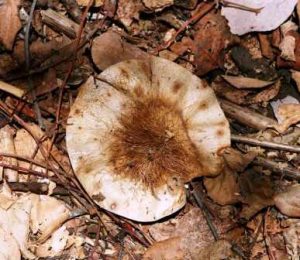
Pterocarpus angolensis. Photo: Bart Wursten. Source: Flora of Zimbabwe
We also saw the Mukwa, Pterocarpus angolensis , with its distinctive fruits. I liked the English names supplied by Myles Standish-White (Prickly fried egg) and Ann Sinclair (Hedgehog with life belt).
Amongst the rocks were the small dark green, truncate leaves of Ficus natalensis. Also, there, growing shyly amongst the humus, one of Zimbabwe’s few stinging nettles, Girardinia diversifolia.
We then walked up to the top of the ridge and along a little way. There were magnificent views over the surrounding hills and farmland. Later, we were picked up by Mark and made our way back to the offices for lunch.
Although it was a short day, there was quite a bit of interest. Our thanks go once again to Mark for his assistance during the visit. We plan to re-visit a different area of Thetford, perhaps in the rainy season.
-Mark Hyde
VISIT TO MONAVALE
This is to report that the Society re-visited Dr Peter Iliff’s plot on the top of a hill in Monavale on Saturday afternoon (26th June, 2004). The unofficial object of the visit was to try and re-find the two rather local species which are known to occur there.
In fact, both were refound, namely the small pink-flowered orchid Polystachya dendrobiiflora, which appeared to be quite common amongst the rocky woodland on the hill.
The second species was the enormous multi-trunked Scolopia zeyheri which dominates an anthill near the edge of the property. This was again flowering nicely and we were able to examine its features.
-Mark Hyde
Jonathan Timberlake follows our palm article in the June Tree Life with this note.
Elaeis palms….. we found a stand, probably semi-naturalised, in the Zambezi Delta near Marromeu. We also saw them from the air in islands in the Rio Lugenda in the Niassa reserve near the North Moz/Tanzania border. Otherwise there are only records from N Lake Malawi and coastal Kenya (and northwards) on our side of the continent.
INDIGENOUS TREES IN FLOWER IN THE GARDEN ALL THE YEAR ROUND.
Indigenous trees in flower in the garden all the year round was the title of a talk I gave recently. It is such a lovely concept that I thought others might like to hear about it too. What a magic garden it would be if we could make it happen. Unfortunately trees are like people, they don’t like being put into boxes and being expected to do the right thing and sometimes they come into flower early and sometimes the flowering season is late and some years they don’t even flower at all.
So let’s start with that question. Why do some trees flower some years and not others. I remember reading a pruning book and being warned that if I over-pruned, the fruit trees would go into a two year cycle. I wondered if indigenous trees suffer the same effect, as if they had been artificially pruned, as a result of drought, fire, frost etc. But no, I have realized that is only part of the solution.
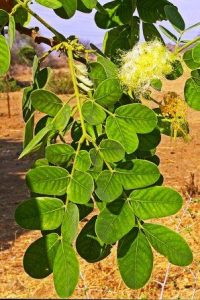
Albizia versicolor. Photo: Meg Coates Palgrave. Source: Flora of Zimbabwe
Trees put so much effort into producing flowers and then fruit that they have to build up their resources before producing flowers and fruit again. For the same reason sometimes there is a delay between flowering and the development of fruit or pods. The one that comes to mind is Albizia versicolor, poison-pod albizia. This flowers in October-November, but the pods only appear from July onwards the following year. When the pods and seeds are still young and if blown down by high winds in August or September they are very toxic and cattle are stupid enough to eat them. I know of one farmer in the Chinoyi area, who systematically chopped out all the poison-pod albizia on the farm. Seems to me a little bit drastic but that was his reaction to losing a number of cattle. It eventually becomes a large tree so would be suitable for the large garden. An Albizia in full flower is spectacular and they mostly flower before the new leaves. There are several to chose from usually flowering between August and November.
The very first being the worm-cure albizia, Albizia anthelmintica, a tree of lower altitudes and very spectacular in white flower when all around is dry and brown.
Some trees have separate male and female flowers, either on different trees or on the same tree, either at the same time or at different times. Some trees produce the male flowers first and then if there are good rains and conditions are right they undergo a sex change and produce female flowers and so are able to produce fruit. One such is the monkeybread Piliostigma thonningii. Those flowers are fairly small but the tree in full flower is quite attractive. I have an idea they can be difficult to grow from seed. I have seen that flowering in January.
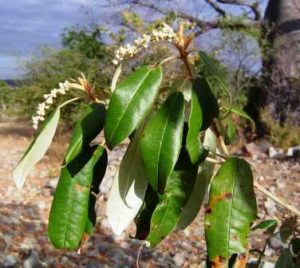
Croton gratissimus. Photo: Bart Wursten. Source: Flora of Zimbabwe
The lavender croton, Croton gratissimus, comes into bud in February during the height of the rainy season but the buds stay closed until the first rains of the next season. The flowers are small produced in a spike with mainly male flowers and one or two female flowers which open after the male flowers have shed their pollen. This is very attractive tree all the year around.
Pappea capensis, the indaba tree, is another that undergoes a sex change with male flowers first, but I think that it is much more fussy about conditions being right as I have seldom seen one in fruit. I have seen this in flower and one would not grow it for its flowers. In fruit it is a spectacular sight. In a garden they would probably get that bit of extra that they need to bear fruit. Apparently it has fruits from February to July so I could include that for April.
Why is this called the indaba tree? Because it is the tree under which Lobengula used to hold meetings at his home and that particular one became known as the Indaba tree. State House in Bulawayo was built on the site of Lobengula’s home and that tree stood there for many years but eventually died and I believe there is a young one growing very close to the original stump. I am sure that it has grown from a root shoot and is part of the original tree. Lobengula became King in 1870 and died in 1894. If he held meetings under that tree it must have been a big tree then and it lived for another 100 years. I think trees probably live a lot longer than we realise and that with the present climatic conditions most of the regeneration is from coppice growth and root shoots and not from seed at all. You know that saying. I am as old as my tongue and a little older than my teeth, some people are a lot older than their teeth. I think with trees they are as old as their trunk and usually older than their roots. Although having said that I do think that a new shoot having grown from a root, once it becomes established, breaks away from the parent tree and develops it own root system.
I was once able to examine the roots of a number of mwanga, Pericopsis angolensis, growing close together and at the time was disappointed because despite an extensive root system none of them were joined as I had expected, but with what I have learnt since I am quite happy that that was quite natural. Having mentioned Pericopsis, they usually bear their purplish pea-shaped flowers in September or October.
Trees with a very extensive root system that live a very long time are the baobabs. You would need quite a big garden, of course. They are quite quick growing in the early stages, flowering and fruiting in 15 to 20 years and they appear to do well at this (Harare) altitude. Although one of those in the Botanic Gardens had the centre bit rot and fall off after about 30 years. I wonder if this is not a natural phenomenon. Apparently baobab trunks are often hollow and have been used for storing water, presumably those which are hollow from the top. Providing the top is stoppered adequately the water is supposed to keep fresh for a long time. Another contributing factor could be that if the bark is damaged it is able to regrow. Just as well, in view of the numbers of hats and mats that we see around, that have been made from the bark.
The flowers are white and about 15 cm in diameter. They open late afternoon to early evening curling back the sepals and petals to expose the central mass of stamens, stay open all night and in the morning the sepals and petals straighten and the flower gradually wilts until the petals slide down over the stamens by the following afternoon. The flowers are obviously pollinated at night and usually by fruit bats. I have heard that fact disputed, but there appears to be too much evidence in support of them being bat pollinated for me to believe otherwise. The pollen is very light and the stigma very receptive so that wind pollination cannot be ruled out and nocturnal insects such as moths and flies have also been observed visiting the flowers. In the past I believed that, while not particularly scented on the tree, the flowers smell putrid after they have fallen. In fact, that is not true, because while still on the tree, they do emit a strong smell of carrion which is presumably attractive to bats. I wonder if my information was an old family observation. Due to the fact that by the time they arrived to look at a tree the flowers were wilting and it was only after they had fallen the smell became obvious. These trees usually flower in November. One legend associated with a baobab is that spirits inhabit the flowers and any one who picks a flower will be eaten by a lion or a crocodile or something. And of course the other one is that the baobab is the upside-down tree. The baobab was so tall and so close to the gods that it was always giving them advice until they became so thoroughly exasperated that they yanked it out of the ground and threw it down so that it landed with its roots in the air.
Probably also bat pollinated is the sausage-tree, Kigelia africana . The flowers are striking, dark maroon with heavy yellow veining on the outside, asymmetric, up to 15 cm across the mouth, containing copious nectar. I have certainly licked the nectar out of the flowers. They are borne on stalks 1 to 11 cm long, in pendulous sprays up to 90 cm long and consisting of up to 50 buds, usually in August and are also reported to smell unpleasant. The buds open in succession, usually two at a time, in the evening and fall the next day. After a flower has been pollinated and fertilized, the rest of the buds on that spray abort so that only one fruit per spray or string develops. Very occasionally more than one flower is fertilised at the same time, resulting in more than one fruit per string. These also do well at most altitudes but are very sensitive to frost.
Another tree, or in fact another genus of trees, whose flowers smell unpleasant are the Terminalias. Once we were staying at Kariba in a cottage next to a Terminalia prunioides
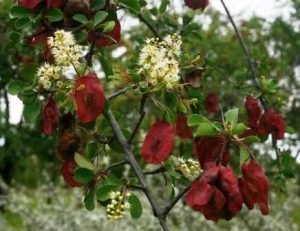
Terminalia prunioides. Photo: Bart Wursten. Source: Flora of Zimbabwe
and my friends christened it “Prunus vulgaris” it was so unpleasant. This is because the flowers are pollinated by insects, which are attracted to by a carrion-like smell. The flowers are white and these insects, probably beetles and flies are those which are obviously most active in the late afternoon or early evening as that is the time that the smell was at its worst. Of course, in pod the purple-pod terminalia is spectacular. I recall it particularly on the road between Messina and the Soutpansberg. I am not sure how successful people have been germinating Terminalia from seed.
Terminalia sericea, the silver terminalia or mangwe is considered a pioneer species being the first to come up in vleis and grassland, but I suspect that is from root shoots and not seed. I know that Prof Braam van Wyk talks of fire maintained grassland and possible those roots have been there for years and once the grassland is protected from fire the tree is able to come through. It is interesting that once a tree has got established how it protects itself against fire by sending out several shoots and making a bush, the side branches growing sideways so they form an insulation layer and also so that they stop the grass from growing and the fire is not able to come too close to the centre, until eventually the centre stem manages to get away. That probably flowers before the rains in September, before or with the new leaves and can be quite attractive – at a distance. When silvery the leaves are also very attractive.
Another fly and beetle pollinated tree is the confetti-tree, Maytenus now Gymnosporia senegalensis. The flowers are very insignificant but are produced in profusion. I think this is at its best attracting insects in the sunshine in the middle of the day. It is called the confetti tree because it is supposed to drop its petals in such profusion that the ground is white with what looks like confetti. I confess I have never seen that but I have friends who have assured me that they have seen it. The flowers are supposed to be functionally unisexual with the sexes on different trees or occasionally on the same tree. Quote and unquote. So much botanical work is done by office botanists on specimens in the herbarium and not by field observations and I would like to speculate and it is pure speculation. Perhaps this is another example of the tree bearing male flowers, followed by female flowers and that one or the other has petals that fall, perhaps the female flowers after being pollinated? but if the female flowers are not produced the petals are not able to fall like confetti. I don’t know. I have one close to my house which I see when I go walking.
It is flowering now and I shall watch it and collect specimens for my friend the office botanist whose specialty is this genus. That flowers from May onwards.
As we are into winter, what more appropriate for mention than the Winter Senna, Senna singueana. For pollination to be successful, and after all, that is the reason plants produce flowers so that they can produce seeds and reproduce themselves, it is necessary for them to be able to attract a pollinating agent such as an insect and furthermore the plant has to ensure that the pollinators return to the same species to pass on the pollen and, while it is still fresh. One way is to have a short defined flowering period or as the Winter Senna does flowers when little else is. And it certainly does brighten up our dull June days.
Insects are sensitive to ultra-violet light and so the best colours to attract them are blue, mauve, purple and yellow, but different insects prefer different colours. Clive Liddle once said: There is always something yellow flowering in the bush and if you watch you will see that is so true, also that very often the little wild flowers have a very short flowering period. Being, and I love this expression, clumped in time and space.
Another tree with yellow flowers is the mukwa, Pterocarpus angolensis which flowers in September before coming into new leaf. I know these grow from truncheons because I inadvertently grew one. I used a chopped down mukwa branch as a clothes-line pole and it grew. I have also seen posts used in a boma growing. Tom Muller say that a branch always knows it is a branch. I believe that growing them from seed is quite easy. The man who ran a nursery near Turk Mine had no trouble. He soaked the pods in water for a couple of days to facilitate taking off the skin with the prickles. I once did it the hard way. I used a file to rub off the prickles. He germinated them in a 2 lt coke bottle having cut off the top which he then put back on and when the seedling was big enough he took the top of for longer and longer periods to let it harden.
And then of course in December we have the round-leaved bloodwood, Pterocarpus rotundifolius flowering. That is very spectacular. We were out at the Matopos one Boxing Day. That was a real eye-opener. We had not realised how many there were in the area. That was a beautiful sunny day. My observation in this part of the world has been that they often flower on a dull day. If there is no sun colours are much brighter and the flowers of this species are a brilliant deep yellow. That may be the reason.
I really enjoy the acacias and one of my favourites is the large-leaf acacia Acacia amythethophylla and I have chosen that one because it usually flowers in February when all the others are have finished. It has flowers in deep orange-yellow round balls which it bears over the top of the tree rather like a yellow flags and of course when the pods appear they are also at the top of the tree. The short dark spines are inconspicuous and often difficult to find. When not in flower with its large leaves and leaflets is can be mistaken for the african-wattle, Peltophorum afracanum. That has sprays of flowers up to 15 cm long which appear from November onwards.
-Meg Coates Palgrave. To be continued.
MARK HYDE CHAIRMAN


